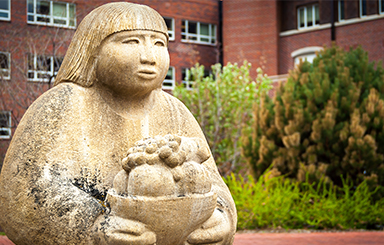DU Researchers Explore Biological Effects of Service Animals on PTSD
A study led by the Institute for Human-Animal Connection is uncovering links between the psychological and physiological effects of service dogs on veterans with PTSD, offering new insights into treatment and post-traumatic growth.

Dogs have proven themselves to be man’s best friend, but when they are used in service to patients with post-traumatic stress disorder (PTSD), they are also an effective, low-cost intervention for reducing symptoms and increasing quality of life. But little is known about how the body—both human and canine—reacts to and changes in response to this human-animal interaction.
That’s why researchers at DU’s Institute for Human-Animal Connection (IHAC) are studying the molecular and physiological changes that occur when veterans and service dogs bond. Supported by a grant from the Human Animal Bond Research Institute, the study explores what happens physically when veterans with service dogs experience post-traumatic growth (PTG)—positive psychological changes that can happen as a result of struggling or dealing with trauma.
The researchers are also measuring the effectiveness of service dogs in treating PTSD and increasing PTG, offering insights that could reveal new drug targets and treatments.
“If we can understand how dogs and humans react—on a molecular level—to each other, a whole new world of drugs, treatments, and protocols could impact the lives of veterans and others living with PTSD,” says Kevin Morris, executive director of IHAC. “Can we, as we like to say, turn the dog into a pill?”
Morris, a molecular biologist by training, says this research will begin to answer some of the questions he’s had for years about the effect of human-animal relationships on health and well-being. “I've been here at DU going on 10 years, and I've been angling to do this study since my first day,” he says.
While there is plenty of proof that service dogs can reduce PTSD symptoms, understanding how is a much more complicated task.
The team is tracking 50 veterans over time, before they get their dogs and then at the one-month, six-month, and 12-month marks, including a post-traumatic growth measure. They’re also tracking the dogs’ behavior and getting their blood samples because, Morris says, “There’s nothing known about how this type of work affects the health and well-being of the dogs themselves.”
The logistics of the study are “formidable,” he says—from finding participants all across the country and collecting surveys on sleep quality, anxiety, depression, social connection, pain levels, and other metrics to collecting blood samples and packing them on dry ice and shipping them to a lab in Colorado.
The blood samples, taken at each interval, are analyzed by a biotech company in Boulder called Somalogic, which is able to measure 10,000 proteins in each sample, allowing researchers to track changes in the expression of proteins over time. The data provides a deep dive into the physiological effects of the human-animal relationship, with researchers correlating changes in protein levels with the reduction of PTSD symptoms in the veterans.
“If we have all these signs that confidently point to PTSD improving—and then these other markers that we don't really understand in the context of PTSD are going up or going down—that gives us some hints for new drug targets and new biological pathways that might be relevant for PTSD,” says Jaci Gandenberger (MSW ’19), a research associate at IHAC. “That's what really opens up the door in terms of future clinical interventions.”
Their research could have implications for not only improving PTSD treatments but also for animal welfare. Understanding how the dogs’ health is affected is crucial to ensuring their well-being in these demanding roles, Morris says. “It’s important that we understand what the impacts of this type of work are, to make sure that the dogs have the best health and well-being that we can provide.”
The end goal of the work is to help as many people with PTSD as possible. “We are focused on military veterans with combat-induced PTSD, but there is a huge population of individuals living with PTSD. It's common in first responders, police and firefighters. It's common in sexual assault victims,” Morris says. “It's not just understanding it for this specific population, but more broadly, understand how PTSD symptoms can be reduced for everyone.”


